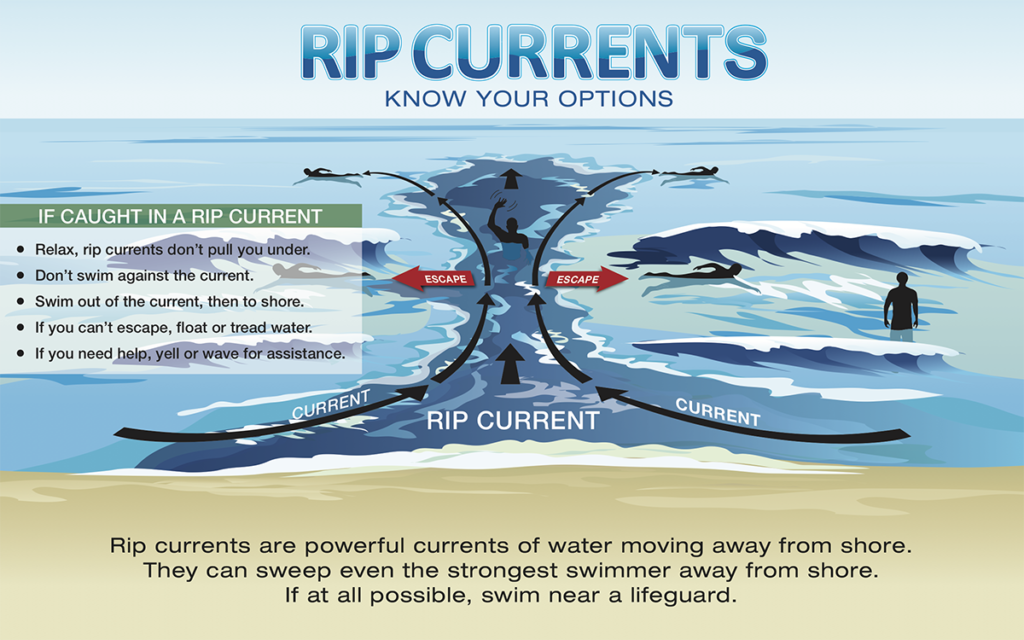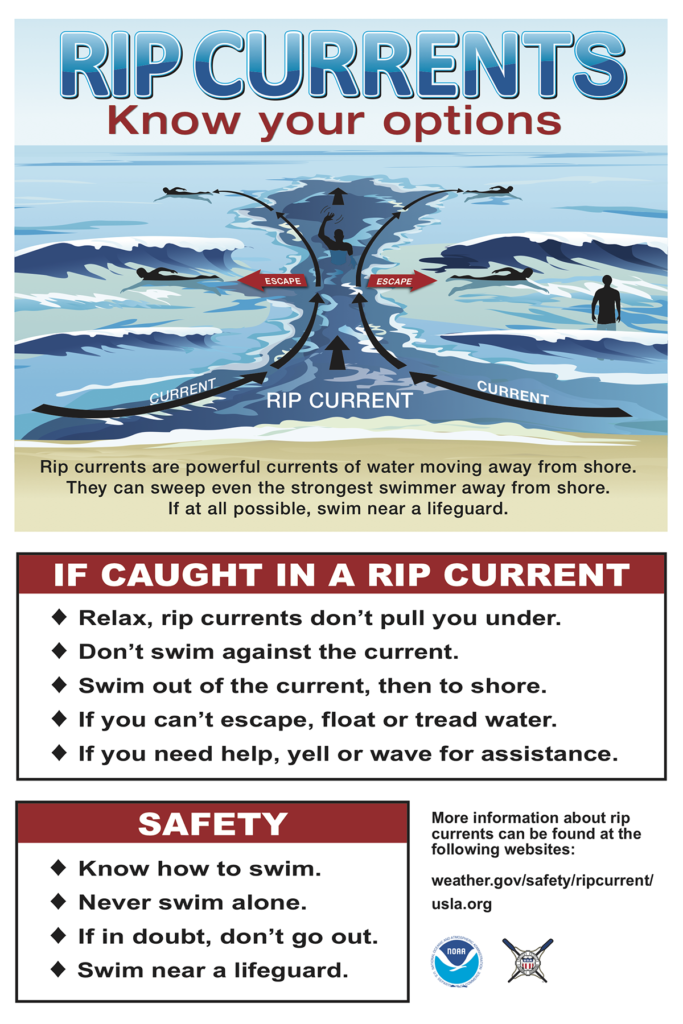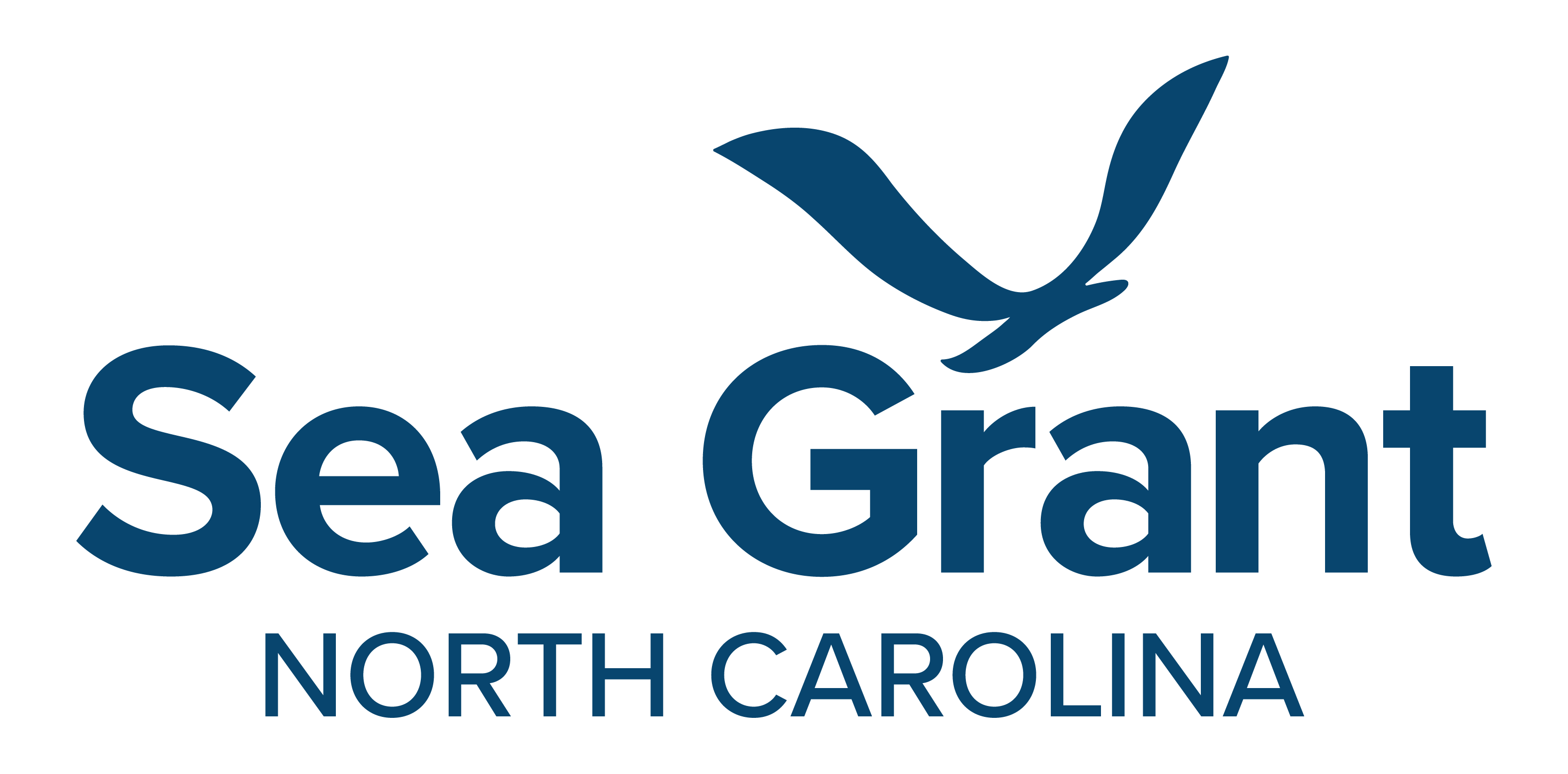Rip Currents
Research and beachgoer safety resources

Rip currents are the leading surf hazard for all beachgoers. The U.S. Lifesaving Association reports 80 percent of all surf rescues are related to rip currents. On many beaches, rip currents are present every day and speeds are too slow to be a danger to most swimmers. However, when wave conditions, shape of the offshore beach and tide elevation are just right, rip currents can reach dangerous speeds.
Rip Current Products

Metal Sign
Rip current signs provide guidance on swimming safety.
This metal sign provides tips on identifying, avoiding and escaping dangerous rip currents. Similar in size to ‘No Parking’ signs (12″ x18″), it has precut holes and identifies the National Weather Service’s online rip current forecasting program. Available in both English and Spanish.
Brochure
This brochure includes illustrations and tips for identifying and escaping these natural hazards. NC Sea Grant has delivered brochures to beach communities.
Magnet
A 5″x7″ magnet contains tips on identifying, avoiding and escaping dangerous rip currents.
To order these products: rejone25@ncsu.edu.
National and State Partners
To learn more about the ongoing national Rip Currents: Know Your Options campaign and rip current safety, visit ripcurrents.noaa.gov and weather.gov/safety/ripcurrent-toolkit.
National Weather Service offices in North Carolina are key partners in working with state agencies and beach communities’ ocean rescue teams. For example, NWS Wilmington, NC has an outreach partnership with NC Department Health and Human Services to reach audiences of people who are deaf and hard-of hearing.
Partners for North Carolina Sea Grant research include:
- UNCW Center for Marine Science
- NWS Wilmington Forecast Office
- U.S. Army Corps of Engineers
- Ocean rescue programs in Carolina Beach
- Wrightsville Beach, Kill Devil Hills and Kitty Hawk
- UNCW Surf Club
- Wrightsville Beach Longboard Association
- Tony Silvagni Surf School in Carolina Beach
- CB Surf Shop in Carolina Beach
- University of New South Wales
NC Sea Grant Rip Current Research
- Discussing Rip Currents — In this interview with WTKF that aired June 20, 2017, Spencer Rogers discussed how to visually identify some of the subtle indicators that a rip current might be present on the beach. Sometimes transient rip currents can appear in a matter of minutes without any indicators. Rogers also also explained what to do if caught in a rip current: Don’t panic, don’t fight the current and swim along the shoreline (parallel) until out of the current before swimming back to shore.
- Exploring Rip Currents — This document by Spencer Rogers highlights North Carolina Sea Grant’s rip current research using data-logging drifters.
News Releases
May 28, 2021: Rip Currents: Know Your Options
North Carolina’s beach communities, offices of the National Weather Service, North Carolina Sea Grant, state and federal parks, and other organizations joined forces again to help keep visitors safe.
May 13, 2020: Rip Current Safety Focus in 2020
Many aspects of visits to the North Carolina coast may be different in 2020, but one constant will remain: Partners up and down the shore are focused on rip current safety.
July 3, 2019: Rip Currents: Know Your Options
In this holiday week, many people will visit North Carolina’s coast for days of surf and sand. Beach-goers always should keep rip current safety in mind. Check out these tips.
Coastwatch Magazine
- Model Behavior, the award-winning feature on the latest in rip currents forecasting and modeling.
- To Catch a Current — A review of Sea Grant’s current and future rip current research, as well as a look into how scientists work together to improve rip current forecasts.
- Currents: Drifters Gather Rip Current Data — What is a data-logging drifter?
- Currents: Beach Season Focuses on Rip Current Safety — The 2014 summer beach season opened with local, state and national attention on surf zone safety.
- Ocean Rescuers Test Skills in Treacherous Waters of the Atlantic — Lifeguards have to be prepared for a variety of emergencies, including knowing how to recognize and respond to rip currents.
- Currents: Improving Rip Current Outlooks — the National Weather Service and lifeguards are working together to improve rip current outlooks.
Coastwatch Currents
North Carolina Sea Grant’s rip current research has been highlighted in our blog, Coastwatch Currents.
- NC Partners Focus on Rip Currents Safety — Learn how North Carolina Sea Grant and partners are focusing on rip currents safety on North Carolina beaches.
- Community Resilience from Coast to Coast — North Carolina Sea Grant’s rip current research is featured in a story map about community resilience efforts across the National Sea Grant network.
- Successful — And Sunny — Drifter Deployment — A chance to share some photos and thank our partners after a productive day.
- Rip Currents: Data and Deployment — A post about the deployment of the data logging drifters that features video taken by University of North Carolina Wilmington graduate student Cobi Christiansen using a GoPro camera.
Rip Currents in the News
- WRAL spoke to Spencer Rogers about the threat rip currents pose
- WWAY spoke to Spencer Rogers about how specially made drifters gather data from rip currents
- Tropical Storm Colin prompted TWC News to talk to Ocean Rescue, NWS and Sea Grant staff about rip currents
- WECT talks to NWS and Ocean Rescue professionals during Rip Current Awareness Week
- WNCN spoke to Spencer Rogers and ocean rescue officials about rip currents ahead of Memorial Day
- WRAL featured a reminder from North Carolina Sea Grant to be cautious of rip currents
- Scientists Stalk Coastal Killer, from the News and Observer
- A segment on rip currents from Good Morning America featuring Spencer Rogers and Rob Brander
